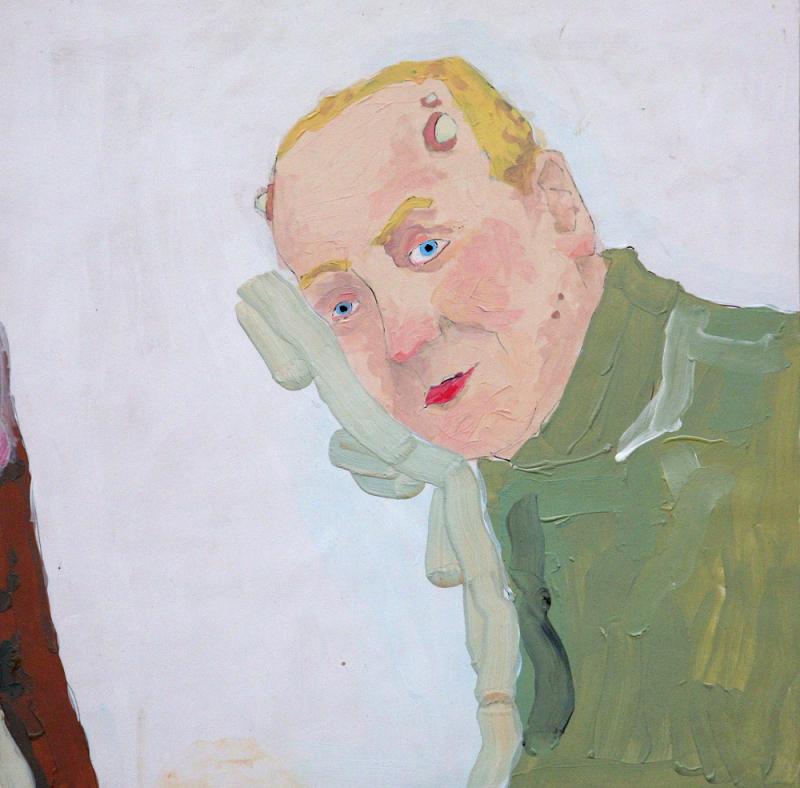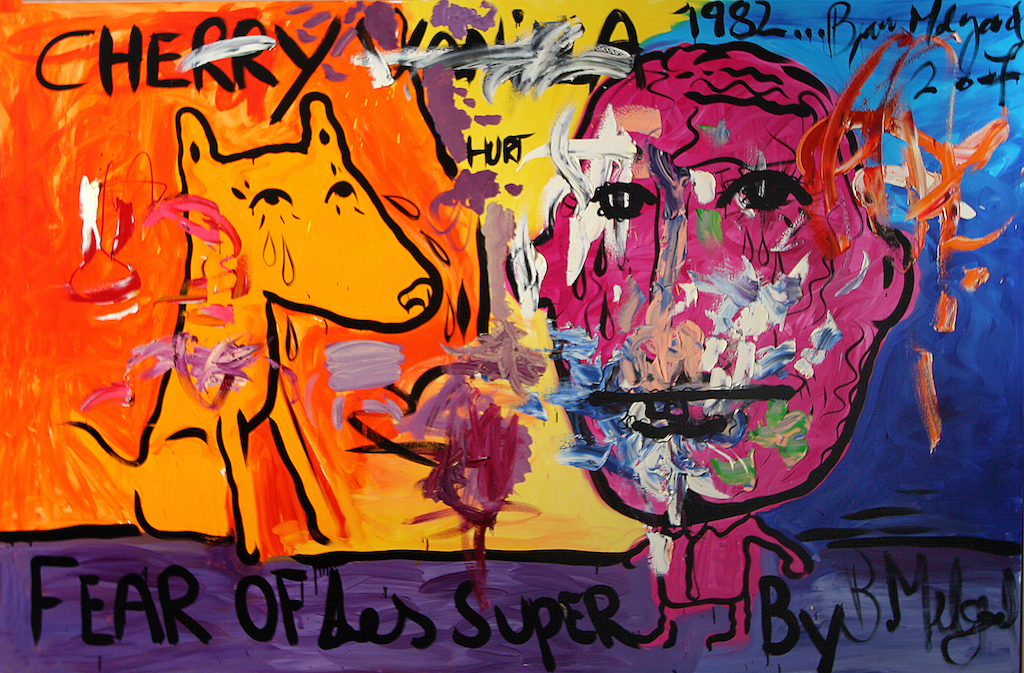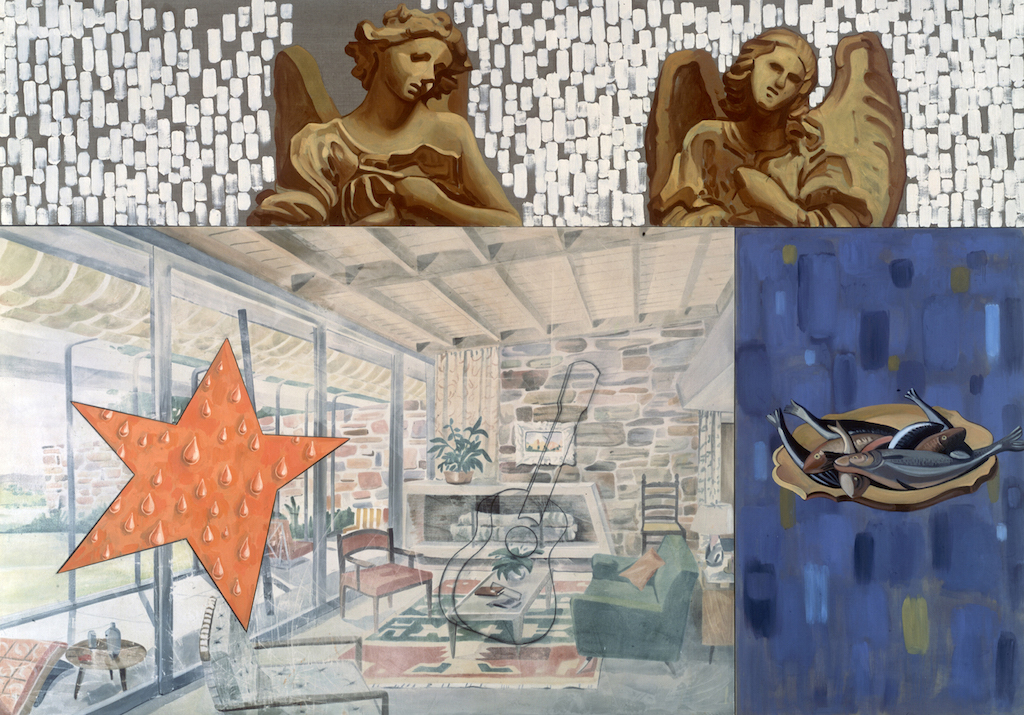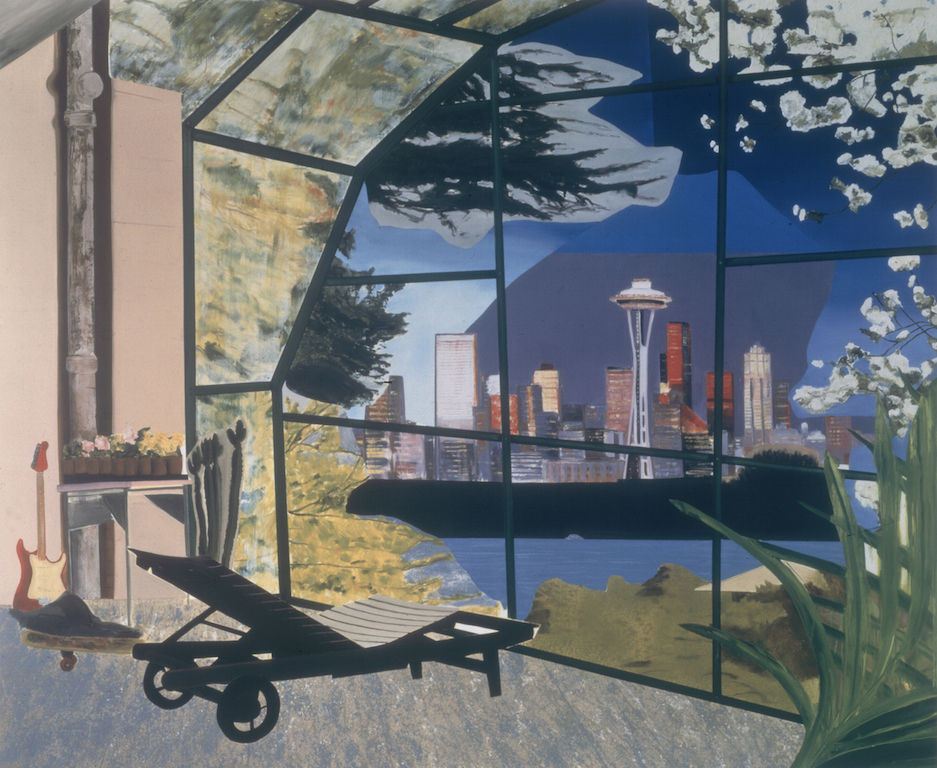Painters’ Painters, Saatchi Gallery | reviews, news & interviews
Painters’ Painters, Saatchi Gallery
Painters’ Painters, Saatchi Gallery
An invigorating look at a medium that not only refuses to die, but invites continual reinvention

The nine artists in this exhibition mainly paint large, eye-catching canvases; yet the most arresting image on show is a tiny, rather tentative picture of an unprepossessing man with yellow hair. It is hard to say why Richard Aldrich’s ethereal Future Portrait no 49, 2003 (main picture) is so compelling.
The forlorn figure leans into the space and cushions his cheek on a band of green brushmarks. His florid pink skin is painted with thin acrylic washes that make him seem insubstantial; yet the fine black lines emphasising his features lend a watchful intensity to his face. The almost hallucinogenic feel of his dreamy presence is enhanced by cherry red lips, bright blue eyes and some weird lumps sprouting from his forehead like incipient horns. He may not seem like someone you’d like to meet, yet the picture is captivating. That is the power of painting.
Aldrich is as much a conceptualist as a painter, though. Each canvas asks a question with a lightness of touch that is extremely refreshing. Past, Present and Future, 2009 addresses the relationship between image and reality. A slash allows you to see through the canvas to the stretcher and wall behind; framing the cut is a charcoal outline of a shape resembling an unstretched canvas. Below it is painted a plant in a hanging basket, while standing on the floor next to it is a real plant. The juxtaposition invites you to compare Aldrich’s dabs of green paint with some actual leaves; his efforts may be unimpressive, yet they are quite adequate. Who needs verisimilitude, he seems to ask, when a camera can do that for you?
 Its a question asked by other exhibitors, in one way or another. Bjarne Melgaard is Norway’s answer to Jean-Michel Basquiat, except that his colours are much brighter than the American’s and his cartoon heads and cute dogs are far more benign and less filled with rage (pictured above: Untitled: Fear of Les Super, 2007). Having said that, the two sharp teeth protruding from the leering mouth of his evil-eyed princess would surely deliver a nasty bite and a dose of rabies.
Its a question asked by other exhibitors, in one way or another. Bjarne Melgaard is Norway’s answer to Jean-Michel Basquiat, except that his colours are much brighter than the American’s and his cartoon heads and cute dogs are far more benign and less filled with rage (pictured above: Untitled: Fear of Les Super, 2007). Having said that, the two sharp teeth protruding from the leering mouth of his evil-eyed princess would surely deliver a nasty bite and a dose of rabies.
While Melgaard takes inspiration from graffiti-covered walls, David Salle thumbs through art history books and interior design magazines. The background of Mingus in Mexico, 1990 is filled with grisaille figures probably culled from a Renaissance fresco with touches of crimson and yellow added. Superimposed are tables, chairs and lamps outlined in blue, a pink speech bubble and a cartoon black Mammy. Two panels are inset; one is a monochrome painting copied from a photograph of a woman drinking, the other is a photographic print of drapery.
Making no attempt towards peaceful co-existence, the disparate elements jostle for one’s attention (if they could, they’d elbow each other out of the way). The painting was made when Salle was considered a hot property and expropriation was the buzz word. Sampling existing material was seen as a way of challenging cherished ideas about authenticity and ownership. Now, though, the visual cacophony he creates feels more like bluster, a way of filling a canvas when you lack ideas of your own.
 Mr Lucky, 1998 (pictured above) is more coherently structured, but is let down by crass drawing. The fish on the plate look plastic, the angels are lumpen and the white brush marks lack vitality. Whereas Aldrich’s nonchalance has the finesse of a tight rope walker, Salle feels like a humourless plodder.
Mr Lucky, 1998 (pictured above) is more coherently structured, but is let down by crass drawing. The fish on the plate look plastic, the angels are lumpen and the white brush marks lack vitality. Whereas Aldrich’s nonchalance has the finesse of a tight rope walker, Salle feels like a humourless plodder.
British painter Dexter Dalwood also uses borrowed imagery, but he melds the various elements into dynamic views of historically significant places which he has heard about but never seen. The peeling blue and cream walls of Brian Jones’ Swimming Pool, 2000 resemble a Clifford Still painting. Showing above the rim of the pool are a bare tree, the house and a tall hedge, all of which are reflected in puddles lying on the floor of the impossibly deep pool. Abstraction and figuration unite to weave an elegant fantasy around the spot where the Rolling Stones guitarist sadly drowned.
Kurt Cobain's Greenhouse, 2000 (pictured below) refers to another rock star’s untimely death. Nirvana’s lead singer supposedly shot himself at his Washington home; but with its painted fragments and proscenium arch of a window, Dalwood’s mock-up of this famous place seems too stagey to be plausible. Named after the spot where invading American forces landed in Cuba, Bay of Pigs, 2004 offers a more convincing view of an iconic place where history was made. With its putrid brown water, tangled vegetation, palm trees and a distant plume of smoke, the imagined landscape is as exotic as a fading dream yet as vivid as a recurrent nightmare.
 David Brian Smith’s landscapes are inhabited by a brooding shepherd who watches over psychedelic sheep coloured orange, green, pink, cream or blue. The artist hails from Shropshire where his father was a shepherd and the pictures are based on old family photographs. You’d have to drop a lot of acid to experience the Shropshire hills with this degree of hallucinatory intensity, though, and the mythic dimension of these visionary scenes makes them hard to relate to.
David Brian Smith’s landscapes are inhabited by a brooding shepherd who watches over psychedelic sheep coloured orange, green, pink, cream or blue. The artist hails from Shropshire where his father was a shepherd and the pictures are based on old family photographs. You’d have to drop a lot of acid to experience the Shropshire hills with this degree of hallucinatory intensity, though, and the mythic dimension of these visionary scenes makes them hard to relate to.
Smith’s Great Expectations – A Windy Day, 2015, is the most recent painting on show. Others date back as far as 1998, which is a shame as it would be good to know where painters like Salle, Dalwood and Aldrich are currently heading; presumably, though, Charles Saatchi has stopped collecting them. Subtitled Artists of Today Who Inspire Artists of Tomorrow, the exhibition is not just an opportunity for painters to check out what their rivals and predecessors have been up to; it also offers an invigorating look at a medium that not only refuses to die, but invites continual reinvention.
- Painter's Painters at the Saatchi Gallery until 28 February 2017
- Read more visual art reviews on theartsdesk
rating
Explore topics
Share this article
The future of Arts Journalism
You can stop theartsdesk.com closing!
We urgently need financing to survive. Our fundraising drive has thus far raised £49,000 but we need to reach £100,000 or we will be forced to close. Please contribute here: https://gofund.me/c3f6033d
And if you can forward this information to anyone who might assist, we’d be grateful.

Subscribe to theartsdesk.com
Thank you for continuing to read our work on theartsdesk.com. For unlimited access to every article in its entirety, including our archive of more than 15,000 pieces, we're asking for £5 per month or £40 per year. We feel it's a very good deal, and hope you do too.
To take a subscription now simply click here.
And if you're looking for that extra gift for a friend or family member, why not treat them to a theartsdesk.com gift subscription?
more Visual arts
 'We are bowled over!' Thank you for your messages of love and support
Much-appreciated words of commendation from readers and the cultural community
'We are bowled over!' Thank you for your messages of love and support
Much-appreciated words of commendation from readers and the cultural community
 Kerry James Marshall: The Histories, Royal Academy review - a triumphant celebration of blackness
Room after room of glorious paintings
Kerry James Marshall: The Histories, Royal Academy review - a triumphant celebration of blackness
Room after room of glorious paintings
 Folkestone Triennial 2025 - landscape, seascape, art lovers' escape
Locally rooted festival brings home many but not all global concerns
Folkestone Triennial 2025 - landscape, seascape, art lovers' escape
Locally rooted festival brings home many but not all global concerns
 Sir Brian Clarke (1953-2025) - a personal tribute
Remembering an artist with a gift for the transcendent
Sir Brian Clarke (1953-2025) - a personal tribute
Remembering an artist with a gift for the transcendent
 Emily Kam Kngwarray, Tate Modern review - glimpses of another world
Pictures that are an affirmation of belonging
Emily Kam Kngwarray, Tate Modern review - glimpses of another world
Pictures that are an affirmation of belonging
 Kiefer / Van Gogh, Royal Academy review - a pairing of opposites
Small scale intensity meets large scale melodrama
Kiefer / Van Gogh, Royal Academy review - a pairing of opposites
Small scale intensity meets large scale melodrama
 Jenny Saville: The Anatomy of Painting, National Portrait Gallery review - a protégé losing her way
A brilliant painter in search of a worthwhile subject
Jenny Saville: The Anatomy of Painting, National Portrait Gallery review - a protégé losing her way
A brilliant painter in search of a worthwhile subject
 Abstract Erotic, Courtauld Gallery review - sculpture that is sensuous, funny and subversive
Testing the boundaries of good taste, and winning
Abstract Erotic, Courtauld Gallery review - sculpture that is sensuous, funny and subversive
Testing the boundaries of good taste, and winning
 Edward Burra, Tate Britain review - watercolour made mainstream
Social satire with a nasty bite
Edward Burra, Tate Britain review - watercolour made mainstream
Social satire with a nasty bite
 Ithell Colquhoun, Tate Britain review - revelations of a weird and wonderful world
Emanations from the unconscious
Ithell Colquhoun, Tate Britain review - revelations of a weird and wonderful world
Emanations from the unconscious
 Rachel Jones: Gated Canyons, Dulwich Picture Gallery review - teeth with a real bite
Mouths have never looked so good
Rachel Jones: Gated Canyons, Dulwich Picture Gallery review - teeth with a real bite
Mouths have never looked so good
 Yoshitomo Nara, Hayward Gallery review - sickeningly cute kids
How to make millions out of kitsch
Yoshitomo Nara, Hayward Gallery review - sickeningly cute kids
How to make millions out of kitsch

Add comment